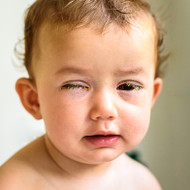Children's Eye Infections
19th Aug 2020

Not sure if I jinxed myself but I had this blog post scheduled for today - and my daughter came down with conjunctivitis yesterday! In our household, this means you get treated like you have leprosy as we try to keep the germs away from Dane. The antibacterial handwash and hand gel is getting a real workout this week!
Not sure how things are in your house but we are paranoid, like seriously paranoid, about any sort of eye infection or eye injury. Maybe you've picked up on that.
Anytime you suspect an eye infection in yourself or your child you should go see your doctor right away. Self-diagnosing an eye infection can lead to improper treatment and could make it worse. If your child wears contact lenses, they should only wear their glasses until they can be seen by your doctor.
Symptoms of an eye infection.
If you child is complaining of any eye pain, strain or their eyes just don’t look right, go to your GP. If you're seasoned eye parents like us and know the signs of things like conjunctivitis you can also head to your optometrist as many are able to prescribe drops.
Also keep an eye out for:
- Red or sore eyes
- Eye discharge or watery eyes
- Dry or itchy eyes
- Light sensitivity
- Swollen eyes or swelling around the eyes
- Blurry vision
What types of eye infections can my child have?
While conjunctivitis (or pink eye as it's sometimes known) is the most common eye infection, the likelihood of others increases if your child wears a contact lens or has had cataract surgery. Types of infections are:
- Conjunctivitis – a common and highly contagious eye infection spread easily at day cares and school.
- Endophthalmitis – this is a serious infection which can happen when the eye is penetrated or from cataract surgery.
- Acanthamoeba keratitis – this is more common for contact lens wearers and involves a parasite getting into the eye. This one causes the most paranoia in our house.
- Other viral eye infections – other infections, such as ocular herpes, is when the eye comes into contact with the herpes virus.
- Fungal keratitis – this can be caused from fungus getting in the eye from things like branches or dirt.
- Trachoma – this is more common in underdeveloped areas and is linked to chlamydia.
Treatments and Prevention
The faster you get your child to the doctor; the faster treatment can begin and the less likely it will turn into anything worse. Viral infections will often resolve on their own but it's best to get things checked just to be sure. In most cases eye drops, or antibiotics will also be used to heal bacterial eye infections. When treated promptly, the recovering time is often very quick.
The best way to avoid eye infections is to wash your hands and to keep your fingers out of your eye. Contact lens wearers need to follow their specific instructions. Children who can’t get anything in their eye, like Dane, need to be sure to wear the appropriate eye gear and follow their specialists’ instructions.
No one likes to deal with an eye infection, but if you suspect anything, always see your doctor immediately. Never put anything in your child’s eye unless you have been directed by your doctor or specialists. Don’t use out of date products and always wash your hands before touching your child’s contact lenses, eye gear or around the eye area.
No infection is good, and the same applies to eye infections.
Information has been sourced from here.

